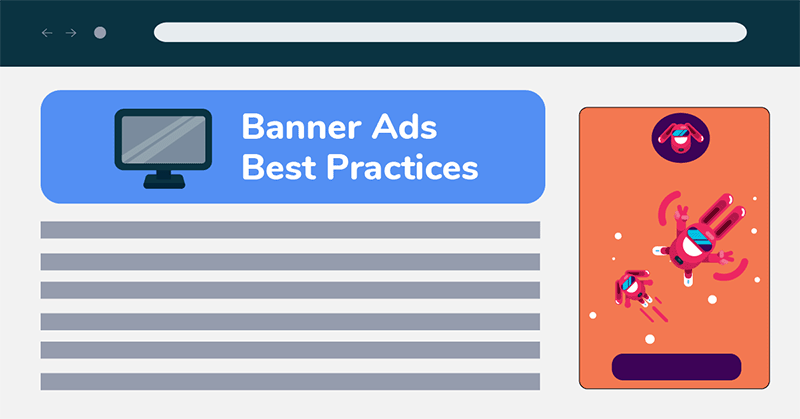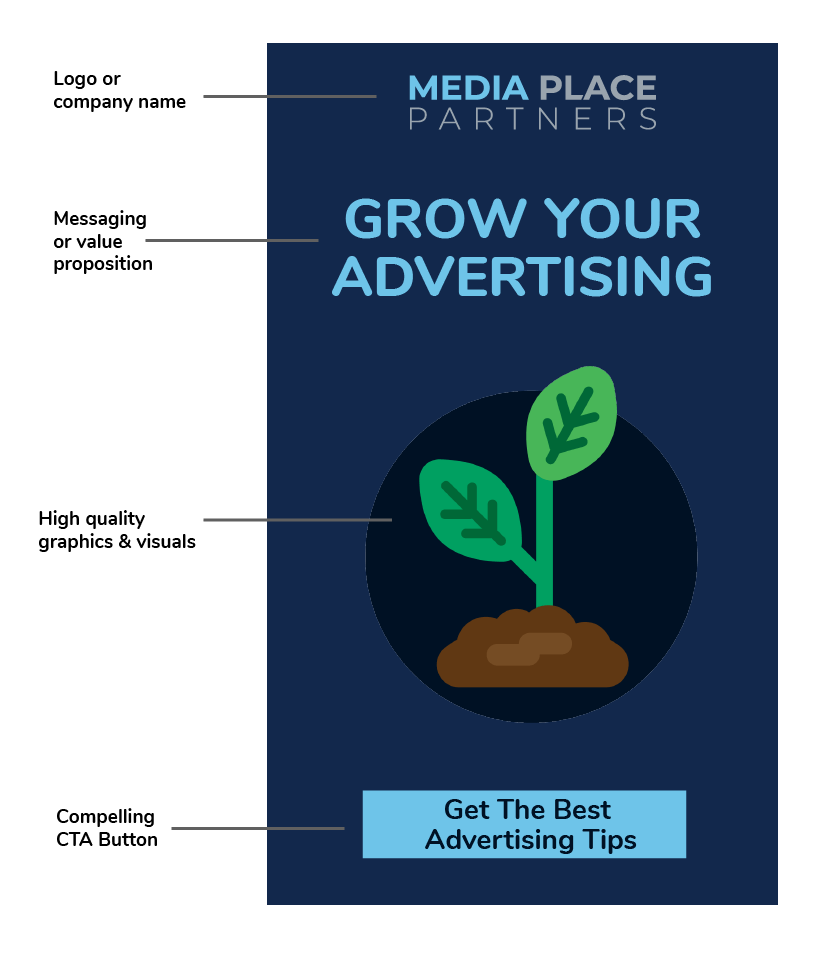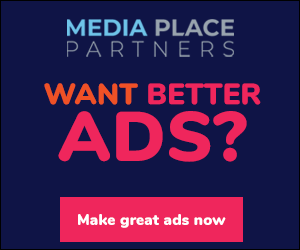Banner Ads Best Practices

Banner Ads 101
This enormous reach makes display advertising a great marketing opportunity for businesses looking to boost awareness. If you want to learn about the other great benefits of display ads, check out our comprehensive overview here. Today, we’re taking a deep dive into the different types of display banner ads available to marketers, the pros and cons of each format, and some best practices to follow so your banner ads are created for optimal ROI.
Banner Ads best practices
Before we dig into the world of banner ads, we want to go over something important – a few banner ads best practices. In the early days of the internet, big ads could slow down web pages or crowd sites with spammy-looking graphics. Now, sites are penalized by search engines and ad exchanges for this behavior. That’s a good thing – these changes are a win-win for marketers and consumers alike. A better ad experience is better for your audience and your bottom line. Below are a few best practices to keep in mind when creating banner ads:

- Be clear and concise. Don’t leave your audience guessing. Banner ads need to show who the ad is for and what the product or service is. The message needs to be clear with engaging, legible text.
- Provide a call to action. Banner ads should always have a Call to Action (CTA), and this CTA must match the landing page. When someone clicks on your ad, they should have an idea of what to expect next. Are they buying tickets for an event? Going to a product page? If they were interested enough to click on your ad, take them exactly where they want to go.
- Keep branding consistent. Landing pages should have the same branding as the banner ad. This includes everything from colors, to fonts, to imagery. Don’t skip out on landing pages – they are a crucial part of ad campaigns.
- Use high-quality visuals. Keep your banner ads professional with high-quality visual elements. This includes photos, text, logos, and videos. High-quality ads are memorable and more enticing to consumers.
- Use smooth animation. Avoid using jerky or flashing animation styles. This can be distracting and reflect poorly on your brand. Keep animation smooth and professional looking.
Types of Banner Ads and their benefits
Variety is the spice of life, and with display advertising, you have choices. Do you want your ads to be animated? Static? Interactive? You can have them all. Here are the most common different banner options available in display advertising, and the pros and cons of each format.
Static Banner Ads
Static banners are the original display advertising format and are still around today. These ads consist of a single image with no audio, video, or animation. Static banners work well for simple and straight-to-the-point messages.JPG, PNG, and GIF files are all acceptable formats for static ads.
JPG
JPG images are easily compressed and can be optimized for size and page speed. JPGs are vibrant, since this format supports 16 million colors. However, JPG is considered a lossy file type. This means the quality of the banner ad will decrease as the size of the file is reduced.
PNG
PNG is a lossless format and an excellent choice for detail rich photos. Images can be easily edited without compromising quality. Because the quality of PNG images is typically higher than JPG, file sizes tend to be larger. It’s important to keep track of your ad file size – to ensure best delivery, display ad servers will not accept ads larger than 150kb.
GIF
GIF images work well when the graphic has large areas of solid color, such as logos and illustrative elements. Since GIF is an 8-bit format, it does well with images that are made up of a limited number of colors. GIF is not ideal for images that are rich in color and texture.
Pros and cons of static banner ads
Pros
- Most ad networks accept static banner ads
- Easily display across devices
- Can be more cost-effective compared to animated ads
Cons
- Messaging needs to be succinct to fit within designated ad space
- No interactive elements
Static banners are an effective way to convey a clear, simple message. Since there is no movement, your logo or brand is in focus longer, making it an effective tool for building brand awareness. Static banners are simple to create and work well for evergreen offers, such as downloading a guide, visiting a webpage to learn more information, or signing up for a newsletter.
Animated banner ads
Animated banner ads put your products and services in motion and tell a story. They allow marketers to give more information about your brand within the designated ad space. We’re going to go over few types of animated banner ads – GIF, HTML5, and In-Banner Video. Although each format supports animation, there are some notable differences between them.
GIF Animation
You’re probably familiar with GIF animations. GIFs aren’t technically videos, but a series of still images played in a sequence, simulating movement. The GIFs you share on social media or through texting look like short, looping video clips.
GIF banner ads act and look differently. If you want an ad that has smooth, video-like animation, use video. The Google Ads platform limits GIF animations to 5 frames per second. This, combined with the maximum 150kb file size, makes it next to impossible to create GIF ads that look like video clips. All those cool GIFs you send in text and messaging apps: not 5 frames per second and not under 150k. Here’s an example of a video-like GIF and an example of a GIF ad. See the difference?


That’s not to say that GIF banner ads don’t have a time and place – there are some benefits to using them. GIFs are relatively simple to create, work well with most devices, and the animation frames are easily controlled and looped. But, there are some drawbacks. Each frame in a GIF animation is an individual image. The more frames you have, the larger the file size will be. The animation effects a GIF can create are also limited in comparison to other formats.
HTML5
HTML5 banners use code to control all animation and transitions. Imagine them as a tiny website built within one ad. Since HTML5 code is embedded into websites, these ads can handle complex animations while following ad server size limits.
HTML5 is supported by all browsers regardless of operating system or device. With HTML5, marketers can integrate animation with rich media, such as video, audio, and other interactive elements. Think buttons that enlarge on mouseover or call to actions that pop in when a user is about to click. Even though there is some complexity involved in building HTML5 banner ads, there are many benefits to using this format.
In-Banner Video (IBV)
In-Banner Video is another type of animated banner. These ads have videos embedded in them that, when triggered, can expand to a large interactive panel that overlays a webpage, or redirect users to the domain where these video ads are hosted. They can also show up as collapsible in-banner ads, which cover a large area of the web page and shrink down to a standard banner ad size.
The user starts these ads by hovering, clicking, or taking some other action on the webpage. Although they are eye-catching, we don’t recommend using IBV. They are data intensive and slow down webpages. Once the video starts to play, there is no way to stop it, which can create more of a distraction than a positive ad experience. Demand is low for IBV – for a reason.
That’s not to say that GIF banner ads don’t have a time and place – there are some benefits to using them. GIFs are relatively simple to create, work well with most devices, and the animation frames are easily controlled and looped. But, there are some drawbacks. Each frame in a GIF animation is an individual image. The more frames you have, the larger the file size will be. The animation effects a GIF can create are also limited in comparison to other formats.
HTML5
HTML5 banners use code to control all animation and transitions. Imagine them as a tiny website built within one ad. Since HTML5 code is embedded into websites, these ads can handle complex animations while following ad server size limits.
HTML5 is supported by all browsers regardless of operating system or device. With HTML5, marketers can integrate animation with rich media, such as video, audio, and other interactive elements. Think buttons that enlarge on mouseover or call to actions that pop in when a user is about to click. Even though there is some complexity involved in building HTML5 banner ads, there are many benefits to using this format.
In-Banner Video (IBV)
In-Banner Video is another type of animated banner. These ads have videos embedded in them that, when triggered, can expand to a large interactive panel that overlays a webpage, or redirect users to the domain where these video ads are hosted. They can also show up as collapsible in-banner ads, which cover a large area of the web page and shrink down to a standard banner ad size.
The user starts these ads by hovering, clicking, or taking some other action on the webpage. Although they are eye-catching, we don’t recommend using IBV. They are data intensive and slow down webpages. Once the video starts to play, there is no way to stop it, which can create more of a distraction than a positive ad experience. Demand is low for IBV – for a reason.
Pros and Cons of animated banner ads
Pros
- Animation offers more flexibility in creativity – you can show your product or service in motion
- Higher user engagement in comparison to static ads
- Measurable metrics beyond CTR
Cons
- File sizes can become heavy when there are multiple frames and elements
- Ad creation may take more time in comparison to static banners
- Can be more expensive to create compared to static ads
There’s no doubt that animated banners are an eye-catching way to get your message in front of your audience. Thanks to modern technology, your ads can integrate with video, audio, and other interactive elements, all while looking great across different devices and screen sizes. With animation, the sky’s the limit – as long as it’s under 150kb.
That’s a wrap
Now that you know all about banner ads best practices, which types are best to run in a display campaign? There’s not one answer – it all depends on your wants and needs. There are a few things to consider: what format works best with your goals? What is your budget? What is your message?
At MPP, we can answer these questions for you. With marketing, it’s often best to try out different tactics to find out what works. Paired with other full-funnel marketing strategies, banner ads can be a powerful way to reach a big audience.


